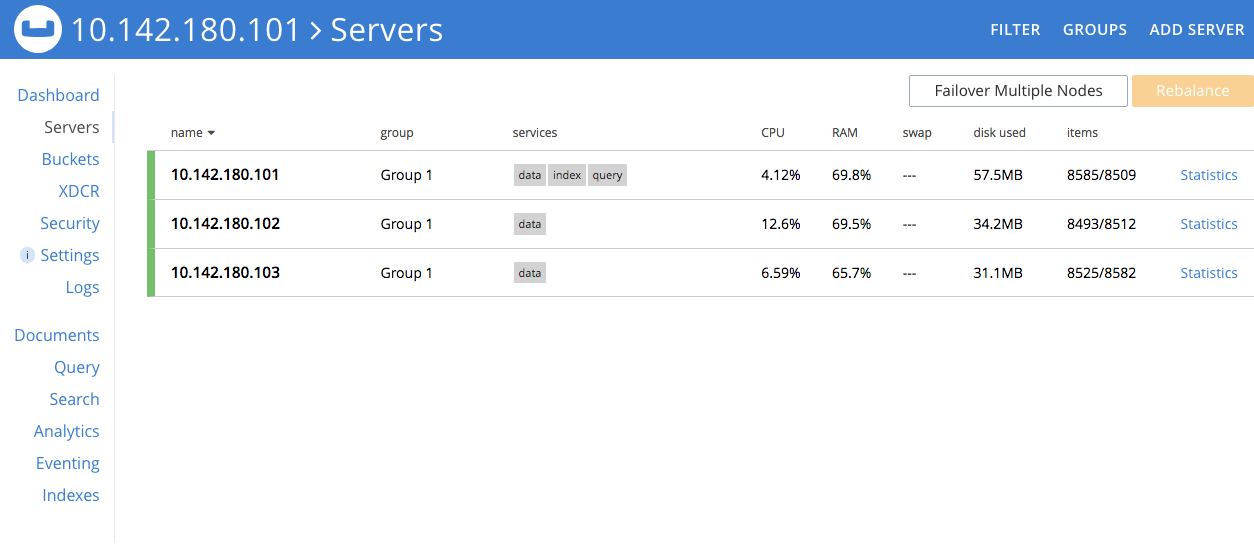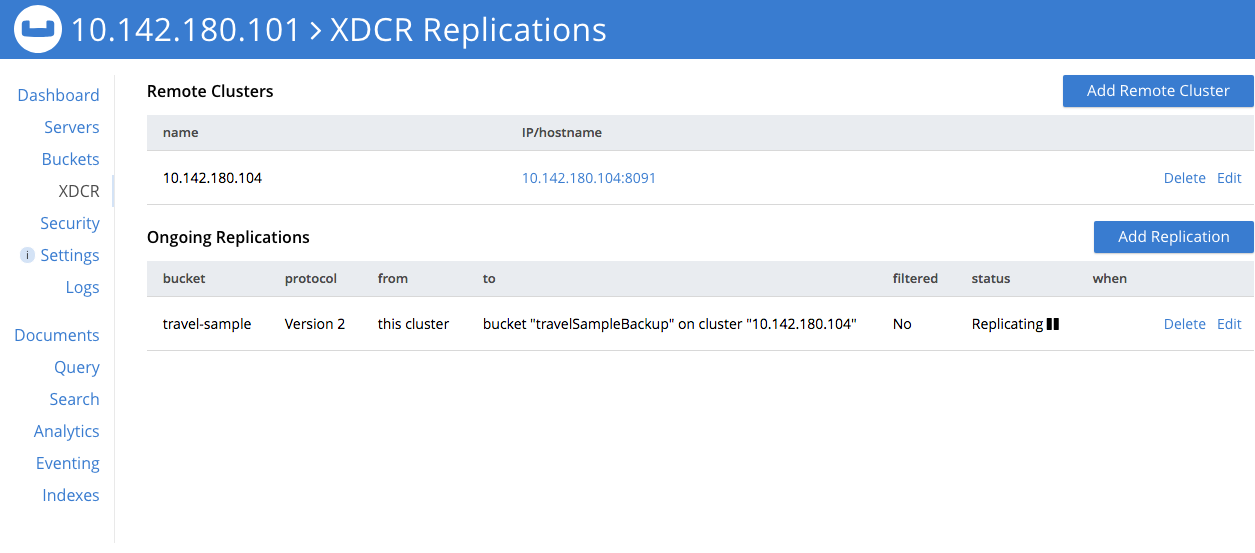Recover Data with XDCR
In the event of data-loss, the cbrecovery tool can be used to restore data. The tool accesses remotely replicated buckets, previously created with XDCR, and copies appropriate subsets of their data back onto the original source-cluster.
Understanding XDCR-Based Data Recovery
Couchbase Server allows one or more replicas to be created for each vBucket on the cluster. This helps to ensure continued data-availability in the event of node-failure.
However, if multiple nodes within a single cluster fail simultaneously, one or more active vBuckets and all their replicas may be affected; meaning that lost data cannot be recovered locally.
In such cases, provided that a bucket affected by such failure has already been established as a source bucket for XDCR, the lost data may be retrieved from the bucket defined on the remote server as the corresponding replication-target. This retrieval is achieved from the command-line, by means of the Couchbase cbrecovery tool.
Recover Lost Data
The illustration below shows a three-node cluster, named 10.142.180.101.

The sample bucket travel-sample has been established across this cluster, with one replica specified.
An XDCR reference to a remote cluster, named 10.142.180.104, has also been established; and a replication started, such that travel-sample is being replicated to the bucket travelSampleBackup, on the remote cluster.

If two of the three nodes in the local cluster become unavailable, the Server screen for the local cluster provides corresponding notifications:

Since travel-sample was established with one replica, the permanent unavailability two nodes out of three means data-loss from the local cluster.
To begin the XDCR-based recovery-process, proceed as follows.
-
If the unavailable nodes and their data absolutely cannot be retrieved, fail each node over, by left-clicking the Failover button. Then, remove each node from the cluster, by left-clicking the Remove button.
-
Before attempting to recover the lost data, restore capacity to the local cluster, as appropriate. The illustration below shows the two nodes that were previously lost, cleansed of all data, powered up, and in the process of being re-added into the cluster:

Do not at this point rebalance the cluster: the rebalance operation affects local vBucket data, and thereby prevents recovery of lost data from the remote cluster. Rebalance will be performed after the lost data has been recovered.
-
Use the cbrecovery tool to restore data to the bucket
travel-sample, from the bucket established on the remote cluster,travelSampleBackup.$ cbrecovery http://10.142.180.104:8091 http://10.142.180.101:8091 \ > -b travelSampleBackup \ > -B travel-sample \ > -u Administrator \ > -p password \ > -U Administrator \ > -P password \ > -vFor information on all parameter-options, see cbrecovery. Used, as shown here, with the verbose option, the command provides extensive console output. The initial portion appears as follows:
Missing vbuckets to be recovered:[{"node": "ns_1@10.142.180.102", "vbuckets": [171, 172, 173, 174, 175, 176, 177, 178, 179, 180, 181, 182, 183, 184, 185, 186, 187, 188, 189, 190, 191, 192, 193, 194, 195, 196, 197, 198, 199, 200, 201, 202, 203, 204, 205, 206, 207, 208, 209, 210, 211, 212, 213, 214, 215, 216, 217, 218, 219, 220, 221, 222, 223, 224, 225, 226, 227, 228, 229, 230, 231, 232, 233, 234, 235, 236, 237, 238, 239, 240, 241, 242, 243, 244, 245, 246, 247, 248, 249, 250, 251, 252, 253, 254, 255, 256, 257, 258, 259, 260, 261, 262, 263, 264, 265, 266, 267, 268, 269, 270, 271, 272, 273, 274, 275, 276, 277, 278, 279, 280, 281, 282, 283, 284, 285, 286, 287, 288, 289, 290, 291, 292, 293, 294, 295, 296, 297, 298, 299, 300, 301, 302, 303, 304, 305, 306, 307, 308, 309, 310, 311, 312, 313, 314, 315, 316, 317, 318, 319, 320, 321, 322, 323, 324, 325, 326, 327, 328, 329, 330, 331, 332, 333, 334, 335, 336, 337, 338, 339, 340, 342, 343, 344, 345, 346, 347, 348, 349, 350, 351, 352, 353, 354, 355, 356, 357, 358, 359, 360, 361, 362, 363, 364, 365, 366, 367, 368, 369, 370, 371, 372, 373, 374, 375, 376, 377, 378, 379, 380, 381, 382, 383, 384, 385, 386, 387, 388, 389, 390, 391, 392, 393, 394, 395, 396, 397, 398, 399, 400, 401, 402, 403, 404, 405, 406, 407, 408, 409, 410, 411, 412, 413, 414, 415, 416, 417, 418, 419, 420, 421, 422, 423, 424, 425, 426, 427, 428, 429, 430, 431, 432, 433, 434, 435, 436, 437, 438, 439, 440, 441, 442, 443, 444, 445, 446, 447, 448, 449, 450, 451, 452, 453, 454, 455, 456, 457, 458, 459, 460, 461, 462, 463, 464, 465, 466, 467, 468, 469, 470, 471, 472, 473, 474, 475, 476, 477, 478, 479, 480, 481, 482, 483, 484, 485, 486, 487, 488, 489, 490, 491, 492, 493, 494, 495, 496, 497, 498, 499, 500, 501, 502, 503, 504, 505, 506, 507, 508, 509, 510, 511]}] 2018-08-13 12:28:07,898: mt cbrecovery... 2018-08-13 12:28:07,898: mt source : http://10.142.180.104:8091 2018-08-13 12:28:07,898: mt sink : http://10.142.180.101:8091 2018-08-13 12:28:07,898: mt opts : {'username': '<xxx>', 'username_destination': 'Administrator', 'verbose': 1, 'extra': {'max_retry': 10.0, 'rehash': 0.0, 'dcp_consumer_queue_length': 1000.0, 'data_only': 1.0, 'uncompress': 0.0, 'nmv_retry': 1.0, 'conflict_resolve': 0.0, 'cbb_max_mb': 100000.0, 'report': 5.0, 'mcd_compatible': 1.0, 'try_xwm': 1.0, 'backoff_cap': 10.0, 'batch_max_bytes': 400000.0, 'report_full': 2000.0, 'flow_control': 1.0, 'batch_max_size': 1000.0, 'seqno': 0.0, 'design_doc_only': 0.0, 'allow_recovery_vb_remap': 1.0, 'recv_min_bytes': 4096.0}, 'collection': None, 'ssl': False, 'threads': 4, 'key': None, 'password': '<xxx>', 'id': None, 'silent': False, 'dry_run': False, 'password_destination': 'password', 'bucket_destination': 'travel-sample', 'vbucket_list': '{"ns_1@10.142.180.102": [171]}', 'separator': '::', 'bucket_source': 'travelSampleBackup'} 2018-08-13 12:28:07,939: mt Starting new HTTP connection (1): 10.142.180.104 2018-08-13 12:28:07,992: mt Starting new HTTP connection (1): 10.142.180.101 2018-08-13 12:28:08,010: mt bucket: travelSampleBackup 2018-08-13 12:28:08,229: w0 source : http://10.142.180.104:8091(travelSampleBackup@10.142.180.104:8091) 2018-08-13 12:28:08,229: w0 sink : http://10.142.180.101:8091(travelSampleBackup@10.142.180.104:8091) 2018-08-13 12:28:08,229: w0 : total | last | per sec 2018-08-13 12:28:08,229: w0 batch : 1 | 1 | 4.6 2018-08-13 12:28:08,230: w0 byte : 21650 | 21650 | 99915.5 2018-08-13 12:28:08,230: w0 msg : 23 | 23 | 106.1 [ ] 0.1% (23/estimated 17018 msgs) bucket: travelSampleBackup, msgs transferred... : total | last | per sec batch : 1 | 1 | 3.3 byte : 21650 | 21650 | 71898.7 msg : 23 | 23 | 76.4 transfer data only. bucket design docs and index meta will be skipped. doneAdditionally, you can monitor the recovery process by means of the Couchbase Web Console: access the Statistics panel for the
travel-samplebucket, on the local cluster; and inspect the contents of the Incoming XDCR Operations panel.When cbrecovery has concluded, a message similar to the following is displayed on the console:
Recovery : Total | Per sec batch : 340 | 1.8 byte : 9708874 | 51930.7 msg : 8509 | 45.5 340 vbuckets recovered with elapsed time 186.96 seconds -
To conclude the data-recovery process, rebalance the nodes on the local cluster, by left-clicking the Rebalance button.
Next Steps
You can monitor an XDCR replication, using either Couchbase Web Console, or the REST API. See Monitor a Replication.